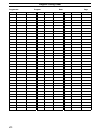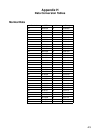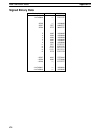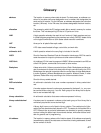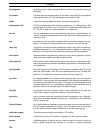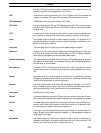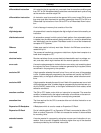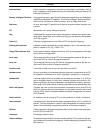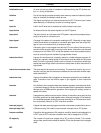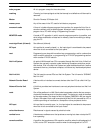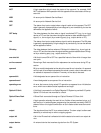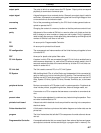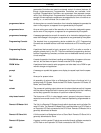
Glossary
481
extended timer A timer created in a program by using two or more timers in succession. Such a
timer is capable of timing longer than any of the standard timers provided by the
individual instructions.
Factory Intelligent Terminal A programming device provided with advanced programming and debugging
capabilities to facilitate PC operation. The Factory Intelligent Terminal also pro-
vides various interfaces for external devices, such as floppy disk drives.
fatal error An error that stops PC operation and requires correction before operation can
continue.
FIT Abbreviation for Factory Intelligent Terminal.
flag A dedicated bit in memory that is set by the system to indicate some type of oper-
ating status. Some flags, such as the carry flag, can also be set by the operator
or via the program.
flicker bit A bit that is programmed to turn ON and OFF at a specific frequency.
floating point decimal A decimal number expressed as a number between 0 and 1 (the mantissa) multi-
plied by a power of 10, e.g., 0.538 x 10
-5
.
Floppy Disk Interface Unit A Unit used to interface a floppy disk drive to a PC so that programs and/or data
can be stored on floppy disks.
force reset The process of forcibly turning OFF a bit via a programming device. Bits are usu-
ally turned OFF as a result of program execution.
force set The process of forcibly turning ON a bit via a programming device. Bits are usu-
ally turned ON as a result of program execution.
function code A two-digit number used to input an instruction into the PC.
hardware error An error originating in the hardware structure (electronic components) of the PC,
as opposed to a software error, which originates in software (i.e., programs).
hexadecimal A number system where all numbers are expressed to the base 16. In a PC all
data is ultimately stored in binary form, however, displays and inputs on Pro-
gramming Devices are often expressed in hexadecimal to simplify operation.
Each group of four binary bits is numerically equivalent to one hexadecimal digit.
Host Link System A system with one or more host computers connected to one or more PCs via
Host Link Units so that the host computer can be used to transfer data to and
from the PC(s). Host Link Systems enable centralized management and control
of PC Systems.
Host Link Unit An interface used to connect a PC to a host computer in a Host Link System.
host computer A computer that is used to transfer data or programs to from a PC in a Host Link
System. The host computer is used for data management and overall system
control. Host computers are generally personal or business computers.
HR area A data area used to store and manipulate data, and to preserve data when pow-
er to the PC is turned OFF.
increment Increasing a numeric value.
indirect address An address whose contents indicates another address. The contents of the sec-
ond address will be used as the operand. Indirect addressing is possible in the
DM area only.



